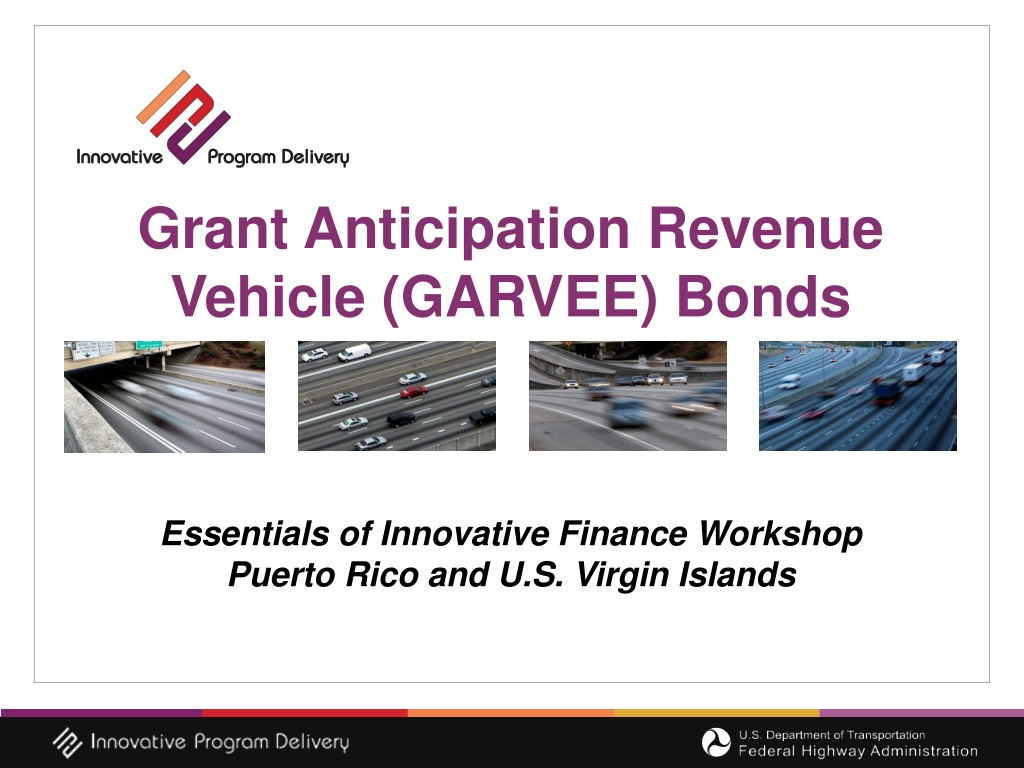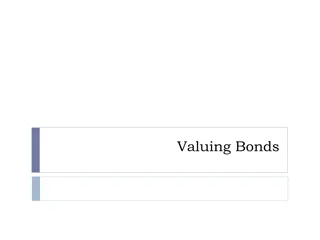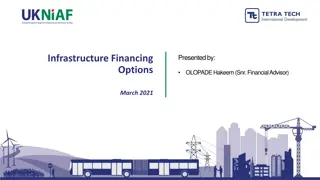Understanding GARVEE Bonds in Infrastructure Finance
Explore the essentials of Grant Anticipation Revenue Vehicle (GARVEE) bonds through an innovative finance workshop in Puerto Rico and the U.S. Virgin Islands. Learn about the types, features, processes, and examples of GARVEE programs, along with the roles and responsibilities of FHWA and states. Discover the advantages and disadvantages of GARVEEs, project eligibility criteria, and the benefits they offer in infrastructure development.
Download Presentation

Please find below an Image/Link to download the presentation.
The content on the website is provided AS IS for your information and personal use only. It may not be sold, licensed, or shared on other websites without obtaining consent from the author. Download presentation by click this link. If you encounter any issues during the download, it is possible that the publisher has removed the file from their server.
E N D
Presentation Transcript
Grant Anticipation Revenue Vehicle (GARVEE) Bonds Essentials of Innovative Finance Workshop Puerto Rico and U.S. Virgin Islands
Grant Anticipation Revenue Vehicle (GARVEE) Bonds Frederick Werner Project Finance Program Manager Office of Innovative Program Delivery Federal Highway Administration Vivian Gutierrez Financial Manager Team Leader Puerto Rico Division Federal Highway Administration
3 Outline Introduction to GARVEE Bonds Types and Features of GARVEEs GARVEE Process Examples of GARVEE Programs Summary Lesson 1 Lesson 2 Lesson 3 Lesson 4 Lesson 5
4 Objectives Describe the various types and characteristics of GARVEEs Identify project eligibility and appropriate uses of GARVEEs Understand the pros and cons of different types of GARVEEs Explain FHWA s and States respective roles and responsibilities related to GARVEEs Become familiar with examples of State GARVEE program and related projects
Lesson 1 Introduction to GARVEE Bonds
6 Grant Anticipation Revenue Vehicles Definition: Bonds, generally tax-exempt, sold by States and backed by and repaid with specific Federal-aid funds Purpose: Issued to provide new funding to an eligible project or to refinance existing bonds Key Provisions: No Federal guarantee of repayment; any pledges or obligations must come from State legislation and/or executive authority Local match is required with every debt service repayment Advantages: Acceleration of construction; low interest rates for new money bonds and re-financings; leveraging of Fed funds Disadvantages: Cost of interest; loss of future flexibility Administration: FHWA establishes rules on GARVEEs; States issue the debt and establish the terms of the bonds
7 Advantagesof GARVEEs Accelerate the construction program Avoid costs of inflation Facilitate large project financing Promote efficient resource allocation by matching debt term with life of asset Provide economies of scale Provide benefit of relatively low interest rates
8 Advantagesof GARVEEs (cont.) Provide economic and fiscal stimulus Leverage Federal funds Increase State s borrowing capacity Reduce use of General Obligation (GO) Bonds Possibly avoid State s GO Bond debt limits and bond referenda Preserve State s general credit rating Allow claim of interest and issuance costs as eligible Federal-aid costs
9 Disadvantages of GARVEEs Debt service reduces financial, programmatic and political flexibility May lead to capacity constraints May lead to induced inflation May limit opportunities for smaller contractors Federal-aid used for interest and issuance costs rather than construction costs May require enabling State legislation and policy Periodic reauthorization risk Significant stewardship, oversight and reporting responsibilities for FHWA
10 Candidate Projects Large-scale capital projects with economic life lasting longer than the bond Projects whose costs of delay outweigh the costs of financing Projects with significant economic development potential Projects must be eligible for Federal-aid highway funding and included in the State Transportation Improvement Plan (STIP)
11 GARVEEs by State (as of Dec. 2012) NH WA ME MT VT ND MN Northern Mariana Islands OR DC MA ID NY WI SD WY MI RI PA IA NE CT OH NJ Guam NV IN UT IL CA CO WV DE VA KS MO KY American Samoa NC MD TN OK AZ NM AR SC GA AL MS TX LA AK VI PR FL HI Issued GARVEE Bonds GARVEE Enabling Legislation Considering GARVEE Enabling Legislation GARVEE Enabling Legislation for sub-State level entities
12 GARVEE Ratings Factors that affect GARVEE bond ratings: Uncertainty regarding Federal-aid Highway Program funding levels Secondary pledge of State revenues to cover debt service Bond insurance Level of pre-existing GARVEE debt service as proportion of Federal-aid program State s overall credit profile History of timely debt service payments
Lesson 2 Types and Features of GARVEEs
14 GARVEE Bond Options Bond Type: Direct or indirect GARVEEs Security: Standalone, backstopped, and/or insured Interest Rate: Fixed or variable Maturity: Long term or short term Uses: New money or refunding Eligibility of debt-related expenses: Assessed in coordination with HQ
15 Direct vs. Indirect GARVEEs Direct GARVEEs Secured by specific future Federal-aid apportionments Bond proceeds pay for specific project(s) Require FHWA Division approval & oversight Total debt service costs (including interest & issuance costs) are eligible for reimbursement Indirect GARVEEs Better term: non- GARVEE debt No FHWA role Secured by anticipated Federal-aid reimbursements on eligible projects paid with State funds Interest & issuance costs not eligible for Federal reimbursement
16 GARVEE Security Options Standalone or non-recourse GARVEEs Future Federal-aid funds serve as the only security backing the Federal share of the obligation to investors No pledge of State funding other than required match Backstopped GARVEEs Additional State revenues pledged in case Federal-aid highway funds prove insufficient Often lower interest costs on the bonds Insured GARVEEs Guarantees payment of bonds for life Comes at a cost (premium charged)
Traditional Financing vs. GARVEE Bonds Cash Flows 17 250 200 with Traditional Financing 150 100 with GARVEE bonds 50 0 Year 1 Year 2 Year 3 Year 4 Year 5 Year 6 Year 7 Year 8 Year 9 Year 10 Total State and Federal Funds - GARVEE Total State and Federal Funds - Regular Federal Aid
18 GARVEE Maturity Options In the past, GARVEEs have been structured to be repaid over one or more traditional reauthorization cycles (6, 12, 18 years) However, GARVEE term can be selected to: Reflect expected life of asset or improvement Take advantage of interest rate environment at issuance date Currently, 10- to 15-year term is common
19 Uses of GARVEE Bond Proceeds New money: Bonds issued to provide new or additional funding for a project Gross funded Deposit exact amount required to pay for project Net funded Amount deposited plus interest earnings sufficient to pay for project Refunding: Bonds issued to refinance certain existing bonds (proceeds used to repay old GARVEEs) Produce interest cost savings Restructure debt service Release issuer from restrictive operating covenants
Lesson 3 GARVEE Process
21 GARVEEs Flow of Funds Tax-Exempt Debt Investors Federal Highway Administration Debt Proceeds Debt Service Federal Apportionments (80%) Issuer (State DOT or Issuing Authority) Matching Source Federal-Aid Eligible Project Costs Debt-Financed Project(s) Non-Federal Match (20%)
22 GARVEE Bonds Issuance: 8 Steps 1. State seeks approval for Advance Construction (AC) of GARVEE project(s) 2. State makes election to receive reimbursements for construction or debt service 3. FHWA (Division Office) approves project as debt- financed project and negotiates project Memorandum of Understanding (MOU) between FHWA and the State 4. State issues GARVEE bonds and uses proceeds for construction of Federal-aid eligible projects
23 GARVEE Bonds Issuance: 8 Steps 5. State requests partial conversion of AC project(s) for semiannual/annual debt service payments 6. FHWA (Division Office) obligates Federal funds for requested debt service payment 7. State claims reimbursement for Federal share of debt service, and FHWA pays State or trustee account directly 8. State uses Federal-aid reimbursement for debt service on bonds
24 Who Controls GARVEE Bonds? FHWA sets the rules on GARVEEs: Project eligibility Expense eligibility Oversight & monitoring State, however, issues the debt and establishes the terms of the bonds
25 State Role Authorize through enabling legislation Place limits on the volume of GARVEE debt that can be issued Structure revenue pledge States (bond issuers) and credit markets determine: Coverage ratios Interest rates Term of the obligation Level of debt service reserves Use of bond insurance
26 Federal Role Provide AC project approval Ensure Federal project and process requirements are met Negotiate MOU Advise on eligibility of debt-related expenses Ensure matching requirements are met for debt service payments Ensure annual debt-service payments are included in STIP/TIP Periodically report on GARVEE activities for information purposes
Lesson 4 Examples of GARVEE Programs
28 Alabama Initially issued in 2002 = $200 million Refunding in 2011 = $91 million County bridge program Replacement of 1,300 weight-restricted bridges across 67 counties $50 million match from G.O. bonds, approved by voters Challenges significant administrative requirements Using GARVEEs at the program vs. project level
29 Alabama (cont.) New bond issuance: Alabama Transportation Rehabilitation and Improvement Program (ATRIP) ATRIP will be used for the rehabilitation and improvement of local transportation infrastructure. Projects are submitted to an Advisory committee and selected based on criteria such as safety, economic impact, industrial impact, education impact, connectivity, project delivery, innovation, and partnership Sold as of Dec. 19, 2012 for a life of 13 years Bonds are rated A by Standard & Poor s Total bond sale of $327,935,000 Goldman Sachs has calculated that True Interest Cost to be 2.27% There are to be multiple issuances under the ATRIP program for a $1 billion total bond program
30 Ohio First State to issue GARVEEs Bonds issued by the Treasurer of State on behalf of ODOT 14 issuances as of 2012 = $1.9 billion Debt service < 20% of Federal-aid funds Federal Funding is set aside off-the-top for forecasted debt service Additional Covenant Other Lawfully Available Funds State gas tax and other state highway appropriations Issued to increase the size of the Construction Program Not for specific projects
31 Ohio (Cont.) Challenges Administration Proceeds used on multiple projects Benefits Generates up-front capital by leveraging future federal funds Build now at historically low borrowing rates, reducing inflation costs on needed projects Assigning proceeds and debt service to each individual project Records Retention Varies depending on length of project, could be up to 20 30 years November 2012 issuance 2.08% Able to spread the cost over the useful life of asset Construction costs only
32 Ohio (Cont.) Best Practices Maturity (Term of Bond) Stay within 2 Federal Reauthorization periods. 10 -12 years. Spending of Proceeds: How quickly will bond proceeds spend out? Ensure we stay within 18 to 24 months due to IRS arbitrage issues. Detailed spreadsheet maintained to assign bond proceeds to each individual project, and to then prorate debt service for reimbursement by FHWA, on a project-by-project basis.
33 Ohio (Cont.) Percent Debt Service of Federal Revenue $1,600 35% $1,471 $1,404 $1,390 $1,378 $1,357 $1,350 $1,400 $1,336 30% $1,232 $1,200 $1,109 25% $1,029 $1,016 $962 $1,000 Millions $909 20% $827 $800 $699 15% $600 11.35% 11.08% 11.66%10.59% 9.30% 10% $400 7.10% 7.08% 6.47% 6.13% 5.77% 3.91% 5% $163 $157 $154 $147 $200 2.75% 2.57% 2.50% $128 1.96% $99 $80 $79 $77 $62 $40 $23 $24 $23 $14 $0 0% 98 99 00 01 02 03 04 05 06 07 08 09 10 11 12 Fiscal Year $ Federal Revenue * The debt service amount is based on the debt service payment schedule. It does not include offsets due to investment income or $ Debt Service * % Debt Service
Lesson 5 Session Summary
35 Review of Objectives Describe the various types and characteristics of GARVEEs Identify project eligibility and appropriate uses of GARVEEs Understand the pros and cons of different types of GARVEEs Explain FHWA s and States respective roles and responsibilities related to GARVEEs Become familiar with examples of State GARVEE program and related projects
36 GARVEE Resources Innovative Program Delivery Office www.fhwa.dot.gov/ipd AASHTO Center for Excellence in Project Finance www.transportation-finance.org Title 23 Section 122 www.access.gpo.gov/uscode/title23/title23.html
37 Contact Information Frederick Werner Project Finance Manager Office of Innovative Program Delivery Federal Highway Administration (404) 562-3680 Frederick.Werner@fhwa.dot.gov
38 Contact Information Vivian Gutierrez Financial Manager Team Leader Puerto Rico Division Federal Highway Administration (787) 771-2512 Vivian.Gutierrez@dot.gov























